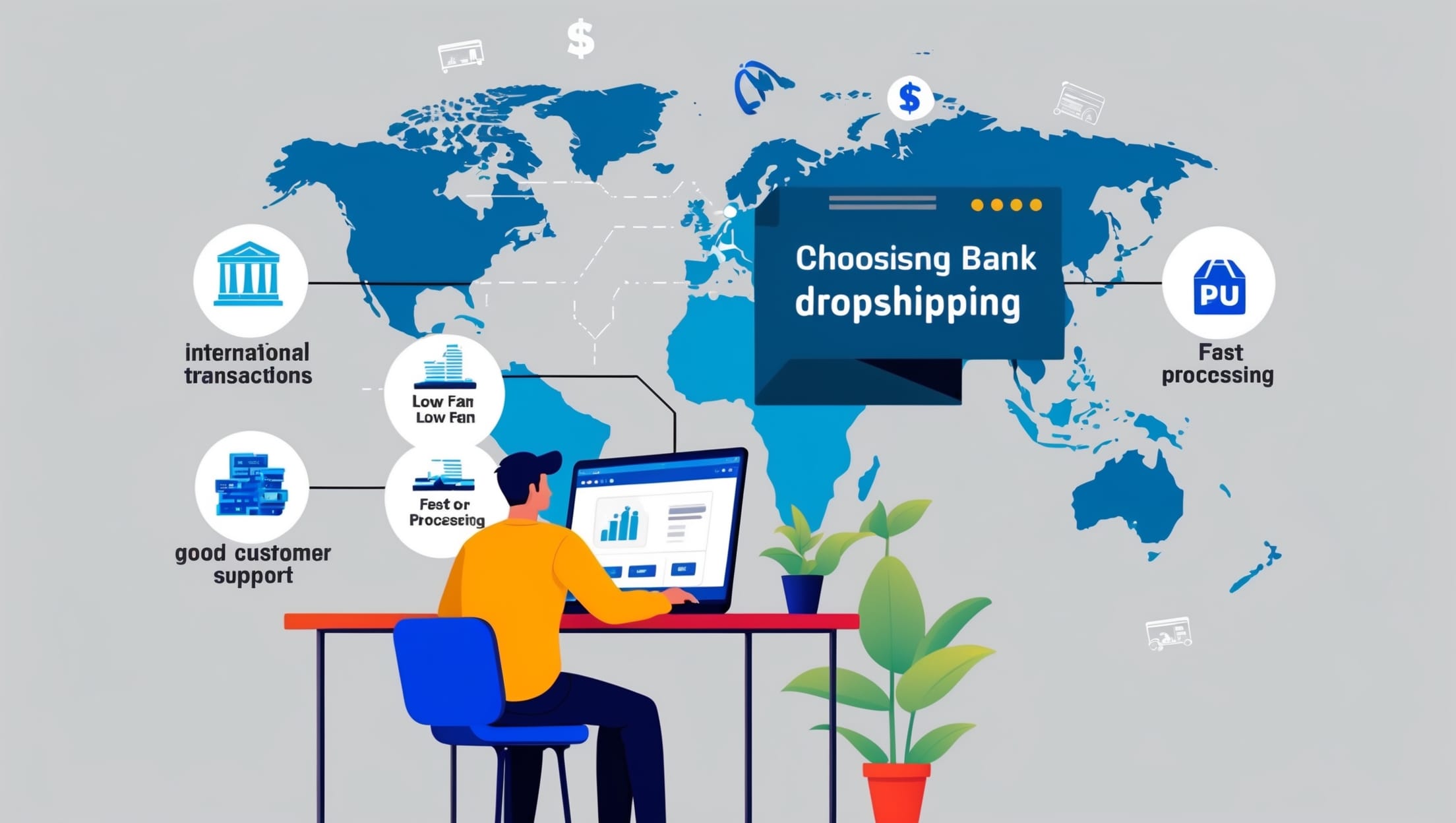Dropshipping is becoming increasingly popular due to its flexibility and ease of entry. However, for success in this field, choosing the right bank is essential. An appropriate banking partner facilitates cash flow management, optimizes costs, and ensures smooth online transactions. In this article, we’ll cover why choosing the right bank is essential, specific banking needs for dropshipping, how bank fees can impact your business, the best online banks for dropshippers, the role of payment solutions, and the key criteria to consider when choosing a bank.
Why Is Choosing the Right Bank for Dropshipping Essential?
Dropshipping requires efficient financial management. Unlike traditional businesses, dropshippers don’t need to manage stock but must handle payments to customers and suppliers swiftly and accurately. The chosen bank should therefore offer specialized services for seamless e-commerce and cash flow optimization. An unsuitable bank could slow down transactions, incur additional fees, or create accounting issues that hinder business growth.
Additionally, online business often involves risks like fraud and disputes. A bank with advanced security tools and services tailored to international transactions can help reduce these risks, allowing you to focus on expanding your business.
What Are the Specific Banking Needs for Dropshipping?
Dropshipping has unique banking needs, as this model relies on recurring and international transactions. Here are some key banking needs:
- Multi-Currency Accounts and International Payments
Dropshipping typically involves suppliers from abroad and customers from around the world. A multi-currency account avoids conversion fees, while strong support for international payments ensures fast, cost-effective transactions. - Access to Online Payment Solutions
Dropshipping platforms require secure payment systems tailored to e-commerce. Online payment gateways allow customers to pay easily using credit cards or options like PayPal, which is critical for converting sales. - Managing Fees and Commissions
Dropshippers need to minimize fees to maintain their profit margins. A bank with reduced fees for international transfers and online transactions can be a major asset. - Accessible and User-Friendly Online Banking Interface
Day-to-day management in dropshipping requires a simple-to-use online bank with easy access to all financial services (transaction history, transfers, real-time notifications). - Available and Responsive Customer Service
A quick response is essential when issues arise (blocked transactions, handling disputes). A bank with efficient customer support ensures smooth operations.
How Can Bank Fees Impact Your Business?
Bank fees can have a significant impact on the profitability of a dropshipping business. Here are some examples of fees that can add up quickly:
- Transaction and Conversion Fees
With payments from different regions, currency conversions and related fees can cut into profits. For example, if a dropshipper primarily sells in the US but uses a supplier overseas, they’ll incur conversion fees on every transaction. - Account Maintenance Fees
Some traditional banks charge monthly fees for account maintenance. By comparison, some online banks have no maintenance fees, benefiting entrepreneurs looking to minimize expenses. - Integration Fees for Payment Solutions
Most online banks work with payment platforms (like Stripe or PayPal), but integration can sometimes incur additional costs. Researching these fees can help you choose a compatible payment solution at optimized costs. - Dispute or Chargeback Fees
Chargebacks are common in e-commerce. Banks often charge handling fees for disputes, which can become costly if the chargeback rate is high.
What Are the Best Online Banks for Dropshipping?
Certain online banks stand out for their ability to meet the specific needs of e-commerce entrepreneurs. Here are some of the best options for dropshippers:
- Chase Business Complete Banking
Chase offers a strong reputation in the US, along with comprehensive business accounts suited for e-commerce. Their Complete Banking accounts provide access to payment processing solutions, making them a great choice for US-based dropshippers. - Novo
Novo is an online bank specifically designed for freelancers and small business owners. With no monthly fees and fee-free ATM usage, Novo is a flexible, affordable option. Novo integrates easily with popular payment platforms and tools, making it easy for dropshippers to manage their business finances. - Mercury
Mercury is a popular choice for US tech startups and online businesses, including dropshippers. Mercury offers easy account setup, no monthly fees, and integrates with most e-commerce platforms. The Mercury platform includes tools for tracking expenses, managing payments, and monitoring account activity. - Wise (formerly TransferWise)
Wise offers multi-currency accounts with low transaction fees and competitive exchange rates. While not a traditional bank, Wise’s international payment solutions are ideal for dropshippers who need to send and receive money in different currencies.
How Do Online Payment Solutions Influence the Choice of Bank?
Online payment solutions are essential for any dropshipping site. The choice of bank should therefore consider its compatibility with these solutions to facilitate payment processing and management.
- Compatibility with Payment Gateways
A bank that is compatible with major payment gateways like PayPal, Stripe, and Shopify Payments simplifies transaction management. It also reduces setup costs and avoids synchronization issues. - Transaction Security
Payment solutions offer security measures (like two-factor authentication) to prevent fraud and ensure customer safety. A bank with strong security protocols for online transactions provides added protection. - Dispute and Chargeback Management
Chargebacks are common in e-commerce. Some banks offer services to handle these disputes in coordination with payment platforms, which can prevent complications and limit fees. - Access to Financial Reports
Payment platforms allow tracking of sales, refunds, and other financial data. A bank that integrates easily with these solutions helps centralize financial data and better manage cash flow.
Criteria to Consider When Choosing a Bank for Dropshipping
Here are the main criteria to evaluate when choosing a bank for dropshipping:
- Transparent Bank Fees
A bank with reduced and transparent fees is essential. Avoid banks with hidden fees to prevent unpleasant surprises. Check for conversion fees, integration fees with payment platforms, and fees for handling disputes. - Multi-Currency and International Payment Options
Dropshippers often need to pay foreign suppliers and receive payments in various currencies. Choosing a bank with multi-currency services and low-cost international transfers can greatly simplify operations. - User-Friendly Interface
Managing a dropshipping business requires regular monitoring. An intuitive and user-friendly interface allows quick access to information and efficient financial management. - Responsive and Available Customer Service
Effective customer support is essential for quickly resolving transaction blockages or handling disputes. Choose a bank with accessible and responsive customer service. - Credit and Financing Options
Some banks offer credit options for e-commerce entrepreneurs, which can be helpful for financing business growth. Access to credit allows you to handle high demand periods or invest in marketing campaigns.
In summary, choosing the right bank for dropshipping is a strategic decision that can impact profitability and operational efficiency. By considering the specific needs of dropshipping, analyzing bank fees, looking at multi-currency and international payment options, compatibility with online payment solutions, and the quality of customer service, you can make an informed choice for your business and focus on its growth.

